The question of the parinibbāna date of Khemā Therī (Aryā Kśemā)
- Tathālokā Bhikkhunī
- Feb 19
- 6 min read
Updated: Feb 27
Tathālokā Therī
February 19, 2025

"The question of the parinibbāna date of Khemā Therī (Aryā Kśemā) the Buddha's leading arahati bhikkhuni disciple 'foremost in wisdom'" - is that now? - together with Mahāpajāpatī Gotamī
- requesting the reply of knowledgeable friends here -
#etadagga #savika #arahati #bhikkhuni #khema #Parinibbana | #bhiksuni #ksema #parinirvanadiwas #Falgun #krishnaasthami | #phagguna #kanhaatthami #uposatha
Rereading the Mahāpajāpatī Gotamī Therī Apadāna (aka Mahāpajāpatī Parinibbāna / Pajāpatī Nibbāna) these past few days in preparation for our upcoming Feb 20th half moon Phagguṇa Puṇṇamī Uposatha commemoration of Mahāpajāpatī & 500 Bhikkhunī Sangha Founders Parinibbāna Day, I noticed something in the beginning, in both the English translations and the two Pāli texts I have access to: that Khemā Therī is right there too.
She was highly commended by the Buddha for her great wisdom, "mahā paññā," in fact, as foremost among the early Bhikkhuni Sangha in this quality. She was appointed by the Buddha as one of his two chief leaders of the Bhikkhunī Sangha. The Buddha on more than one occasion pointed to her as an exemplar that all his lay disciples should guide their daughters to look to as a role model. And the Buddha spoke of her not only as his "heart heir" and "Dhamma heir" but as his daughter, though she was not a biological sibling of the Buddha's son Rāhula.
But she was not, by any accounts, one of the founding 500.
Rather, the story goes, that her husband, King Bimbisārā, a great admirer of the Buddha, recommended her to go hear the Buddha's teaching at the Veluvana Bamboo Forest Monastery outside Rājagaha (now Rajgir), and when she went, into his presence, the Dhamma that he displayed to her and spoke to her was so compelling that "she attained to arahathood right there standing in her royal finery," as a laywomen (a rare case). Thereupon the Buddha himself asked her join him/them as a member of the monastic Sangha.
After going home and explaining what happened, her royal husband King Bimbisāra, with great confidence in the Buddha, not only gave his permission and blessings, but sent her off with highest honors and full entourage to join the [note, already-existing] Bhikkhunī Sangha.
And yet, here she is up front in one of the greatest Parinibbāna stories of all time, saying: "I feel the same, let's go," and apparently going to join this [wrongly-named] "mass extinction" together without further comment, other than the words 'adikānam' which acknowledge her leading role at the time, at the great Vesali (now Vaishali) bhikkhunī upassaya monastery/nunnery/retreat of Mahāpajāpatī Gotamī and whoever was then still alive among the "courageous 500" founding Sakya bhikkhunīs.
I wonder if there are varying versions - perhaps in manuscript traditions? I've noticed that, in the telling, sometimes "peace," and "sublime peace" or "higher peace" is said here, which is of course the meaning of her name:
'Vivaṭaṃ amatadvāraṃ khemaṃ nibbānapattiyā "opened is the door to the Deathless, leading to peace, for the attainment of Nibbāna") A III.354'
. . .
Here with Dhammadharini as part of our #HerStoryOurStory initiative for the restoration and preservation of #BuddhistHeritage, we have been commemorating the Parinibbāna of Mahāpajāpatī and the Founding Bhikkhunī Sangha annually since 2012, for the past 13 years. Up till now, we have not been commemorating great arahatī Khemā Therī's together at this time. This may be the first...
. . .
Have any of my highly learned venerable Buddhist monastic friends learned about this?
Annie Heckman, do you have any insights to share from the Tibetan texts?
Trent Walker, any insights to share from the Southeast Asian manuscript traditions?
"Bhikkhus, among my bhikkhuni disciples who have great wisdom, Khemā is first and foremost."
“Etadaggaṁ, bhikkhave, mama sāvikānaṁ bhikkhunīnaṁ Mahāpaññānaṁ yadidaṁ khemā.
Names she is known by:
Arya Kshema / Kṣemā / Arya Kshema
ඛේමා මහා රහත් තෙරණිය
Sinhala: Khēmā Mahārahat Theraṇiya
พระนางเขมาเถรี
Thai: Phra Nāng (Venerable Lady) Khemā Therī
ព្រះនាងខេមាថេរី
Khmer: Preah Neung (Venerable Lady) Khemā Therī
ຣະຫັນພິກຂຸນີ ເຂມາເຖຣີ
Lao: Bhikkhunī Khemā Therī
讖摩 比丘尼
Chinese: Chèn mó bǐqiūní
*Kṣema Bhikkhunī
智慧聰 明,讖摩比丘尼是。
“Among my ordained disciples, the foremost of those who of those who are wise and intelligent is the bhikkhunī Khemā.”
- the Buddha
as translated by Ven. Bhikkhu Anālayo, p100 of Women in Early Indian Buddhism, translating EA 5.1 = Ekottarāgama 增壹阿含經: Chapter 5.1: 增壹阿含經比丘尼品第五
「 我聲聞中第一比丘尼,智慧聰 明,所謂讖摩比丘尼是。
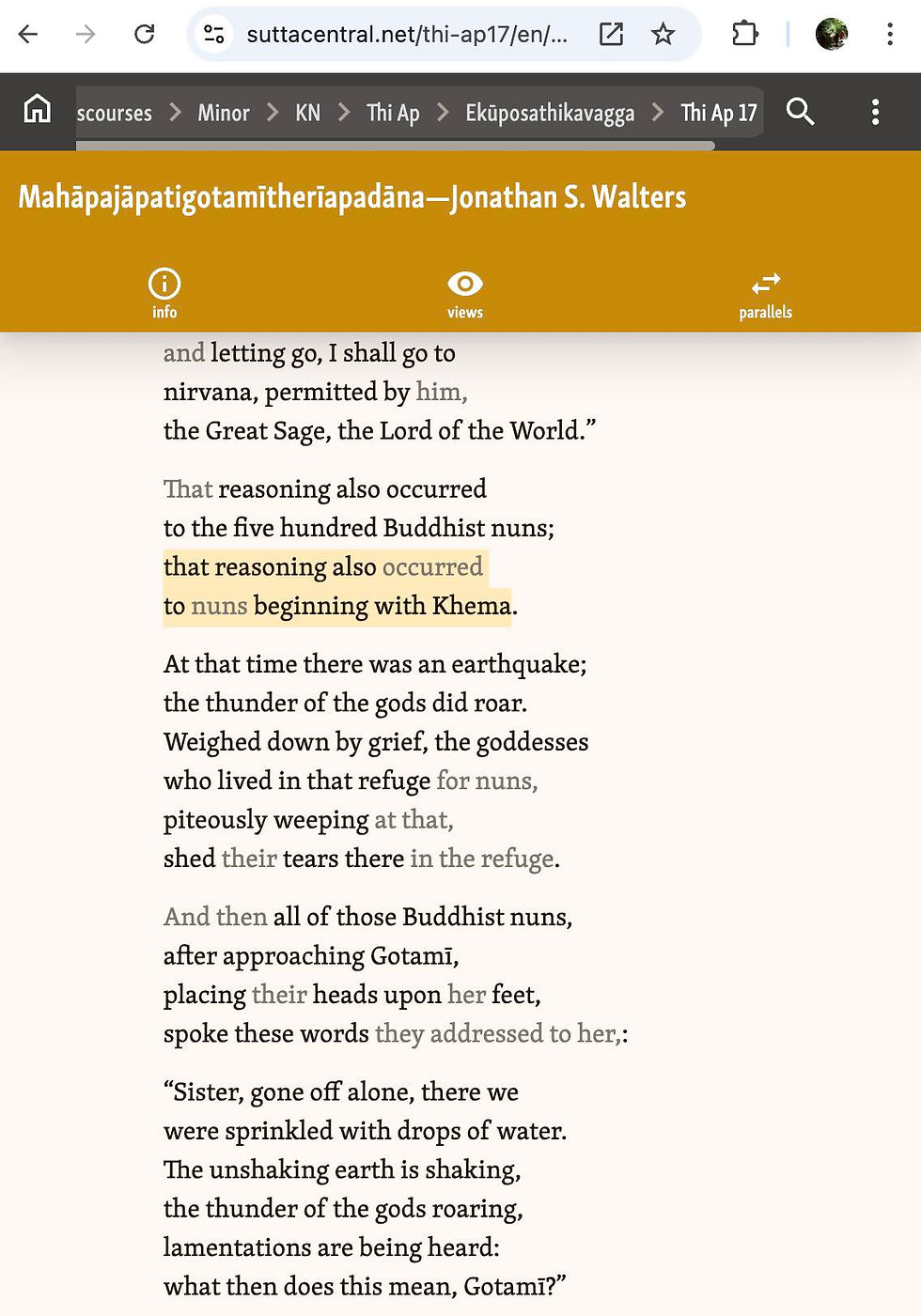

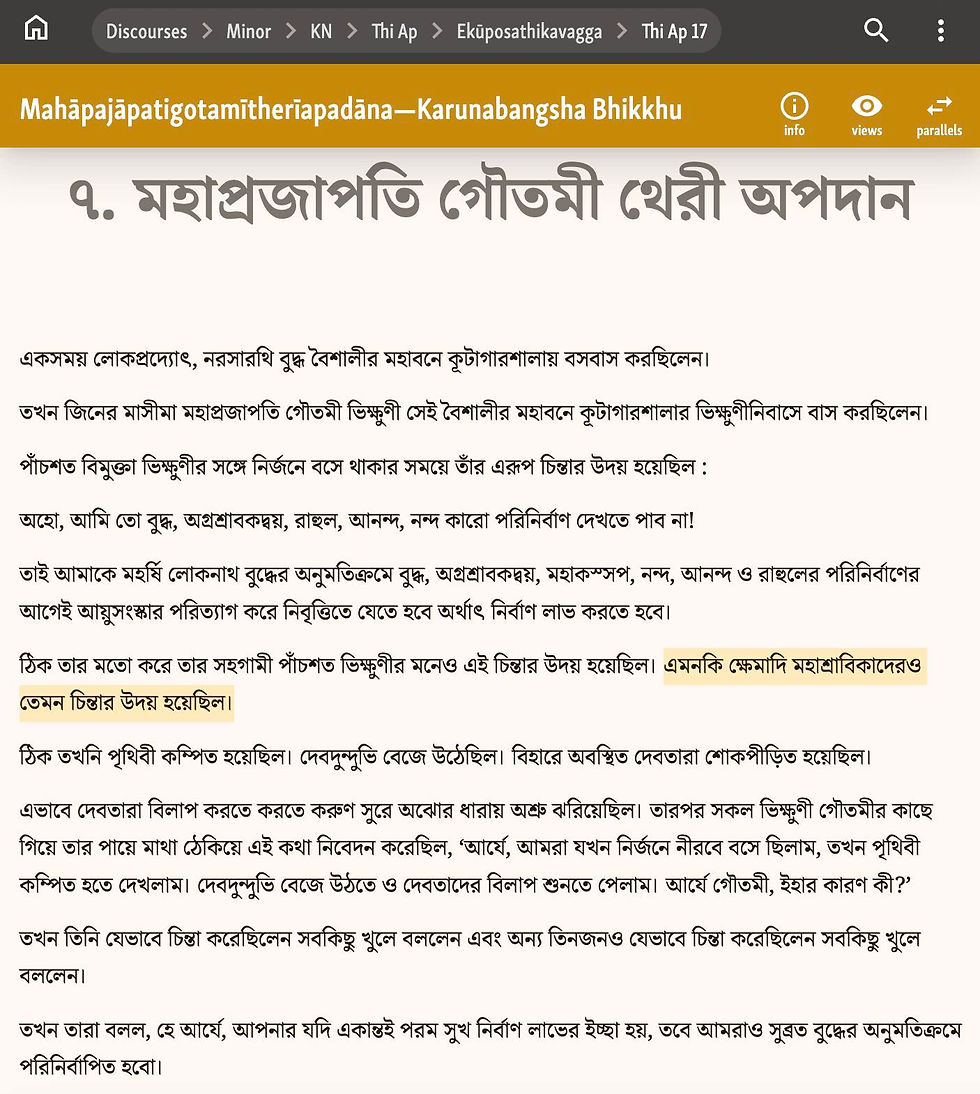



I've reviewed and Khemā Therī's presence does not appear to be mentioned in the Mūlasarvāstivāda Vinaya parallels to the Pāli text Gotamī Therī Apadāna preserved in Chinese and Tibetan: "The Parinirvāṇa of Mahāprajāpatī Gautamī and Her Followers in the Mūlasarvāstivāda Vinaya (Part 1)" English translation by Ven. Bhikkhunī Dhammadinnā:
However noting, in the Ekottarika-āgama parallel preserved in Chinese translation of the "Gotamī-apadāna" (Ap 17) p 367-373, translated into English by Ven. Bhikkhu Anālayo in Ekottarika-āgama Studies,
Khemā's Therī's leadership is also mentioned, and Uppalavannā Therī's presence and involvement is noted as well, together with several other leading arhant bhikkhunīs who are not normally considered to be among the 500 members of the founding mothers of the Bhikkhunī Sangha:
"At that time the nun Khemā, the nun Uppalavaṇṇā, the nun Kisā[gotamī], the nun Sakulā, the nun Sāmā, the nun Paṭācārā, the nun *Bhaddacālā, the nun [Bhaddā] Kaccānā, the nun [Vi]jayā, and five hundred nuns approached the Buddha and stood to one side.26 Then the five hundred nuns, with the nun Khemā at their
head, said to the Buddha:
"We all heard that the Tathāgata will soon enter complete extinction. We cannot stand seeing the Blessed One and Ānanda enter complete extinction first.27 We only wish that the Blessed One would permit us to enter complete extinction first. We would now enter Nirvāṇa, this being proper and suitable."
Then the Blessed One approved it by remaining silent. [822a]
When the nun Khemā and the five hundred nuns saw that the Blessed One had approved it by remaining silent, they came forward to pay respect at the Buddha's feet, circumambulated him three times, withdrew and in turn left to return to their
former dwellings."...
..."At that time the nun Khemā, the nun Uppalavaṇṇā, the nun Kisāgotamī, the nun Sakulā, the nun Sāmā, the nun Paṭācārā, the nun [Bhaddā] Kaccānā, the nun [Vi]jayā, being at the head of five hundred nuns, [822b] each put down their sitting cloths in
an open place and soared up into the empty sky. [While] sitting, lying down, standing, and walking in the empty sky, they performed eighteen transformations … up to … they entered into the cessation of perception and knowing … and each of them entered complete extinction.33"
We see here that both the Pāli text and the parallel Chinese Ekottarika Āgama seem to assert that not only was Khemā Therī present and a participant in Mahāpajāpatī Gotamī Therī's Parinibbāna, but that it was Khemā Therī's idea, and with her leadership, that [all or the remainder of] the 500 Bhikkhuni Sangha founding mothers all enter parinibbāna together.

The 佛母般泥洹經 "Sutta on the Buddha's Mother's Pārinibbāna" parallel does not appear to mention Khemā Therī, or Uppalavannā Therī, here - just the 500 bhikkhunī followers of Mahāpajāpatī Gotamī, here known as 大愛道 Mahā Pīyapathī "She to Whom the Path is Dear".
If any Chinese readers take a look, please let me know if you see Khemā of Great Wisdom here.

Sāvaka-nibbāna literature of Siam, Laos and Cambodia includes Pajāpatīnibbāna aka Mahāpajāpatīgotamī Parinibbāna manuscripts (see pp 189-190 of "Sāvaka-nibbāna literature"). It would be useful to check these manuscripts and see if Arahat Khemā Therī is regularly included in the Pajāpatī Nibbāna or not.
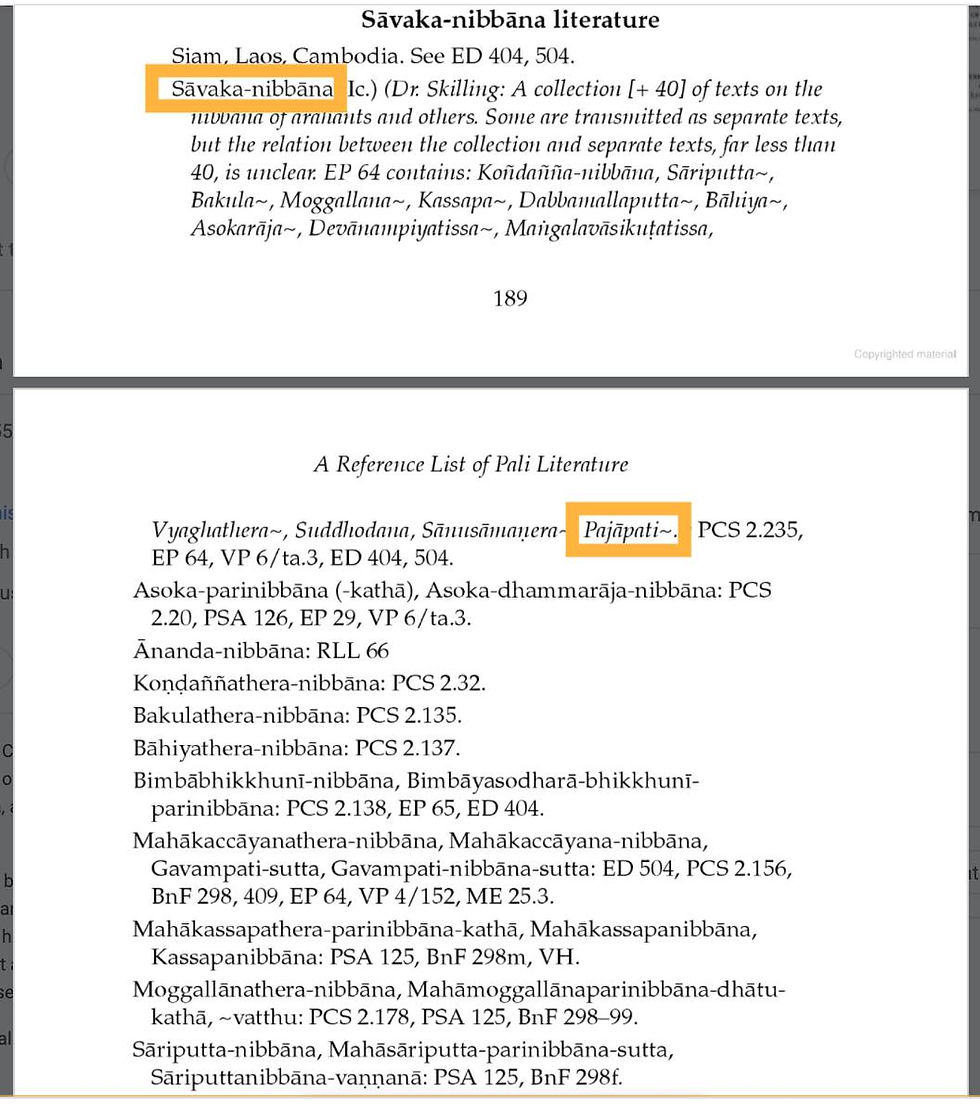
It would be worthy to check the old Pāli manuscript (Khom / Khamaya script)
Pièce 64 - បាឡីសាវកនិព្ពាន : Pāḷī Sāvakanibbāna Mahāpajāpatīnibbāna មហាបជាបតិគោតមិ បរិនិព្វាន (liasse 5) at the EFEO Bibliothèque de l'École française d'Extrême-Orient (Paris)
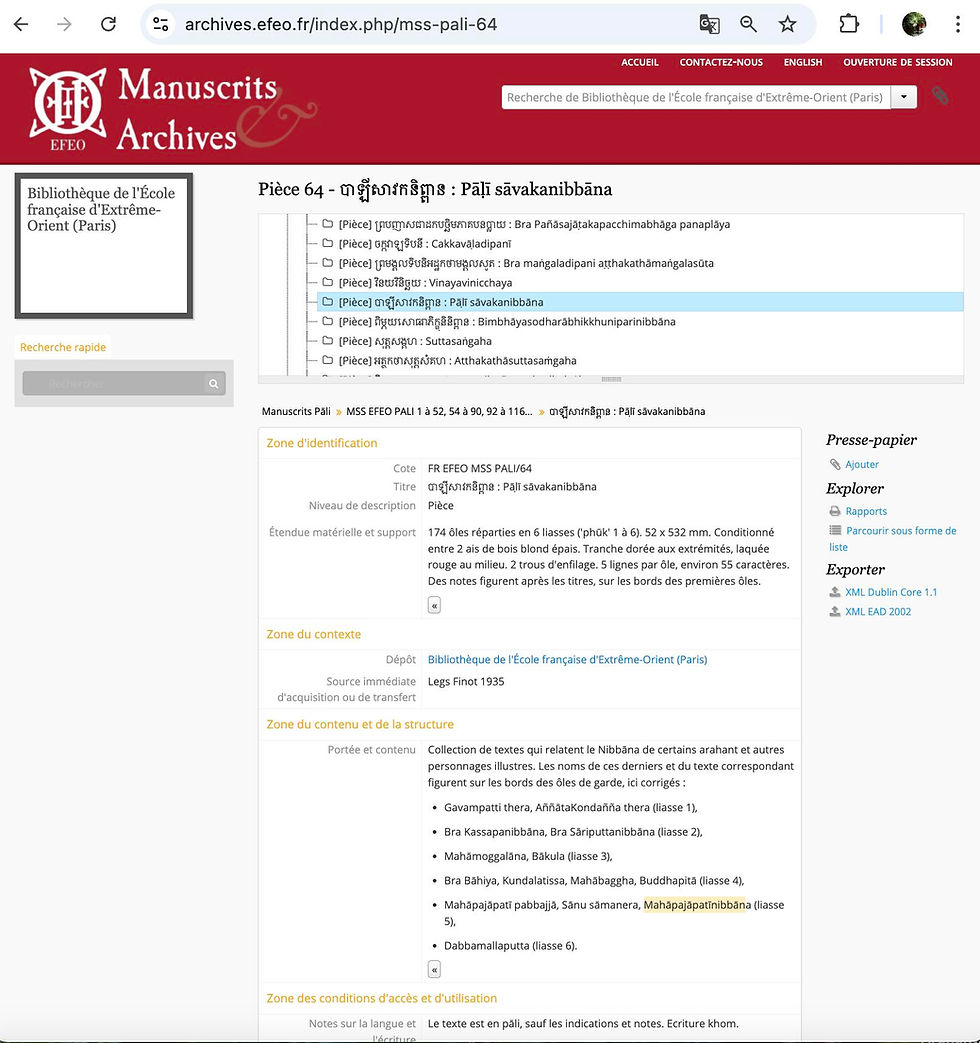
English translation of the French above from Google Translate

Igatpuri Vipassana Research Institute Chaṭṭha Saṅgāyana Tipitaka also has in the महापजापतिगोतमीथेरीअपदानं :
१०३. ‘‘तथा पञ्चसतानम्पि, भिक्खुनीनं वितक्कितं।
आसि खेमादिकानम्पि, एतदेव वितक्कितं॥
Please see the text (p 367-373) here for the Ekottarika Āgama Apadāna 17 parallel preserved in the Chinese Taisho Tripitaka (link)
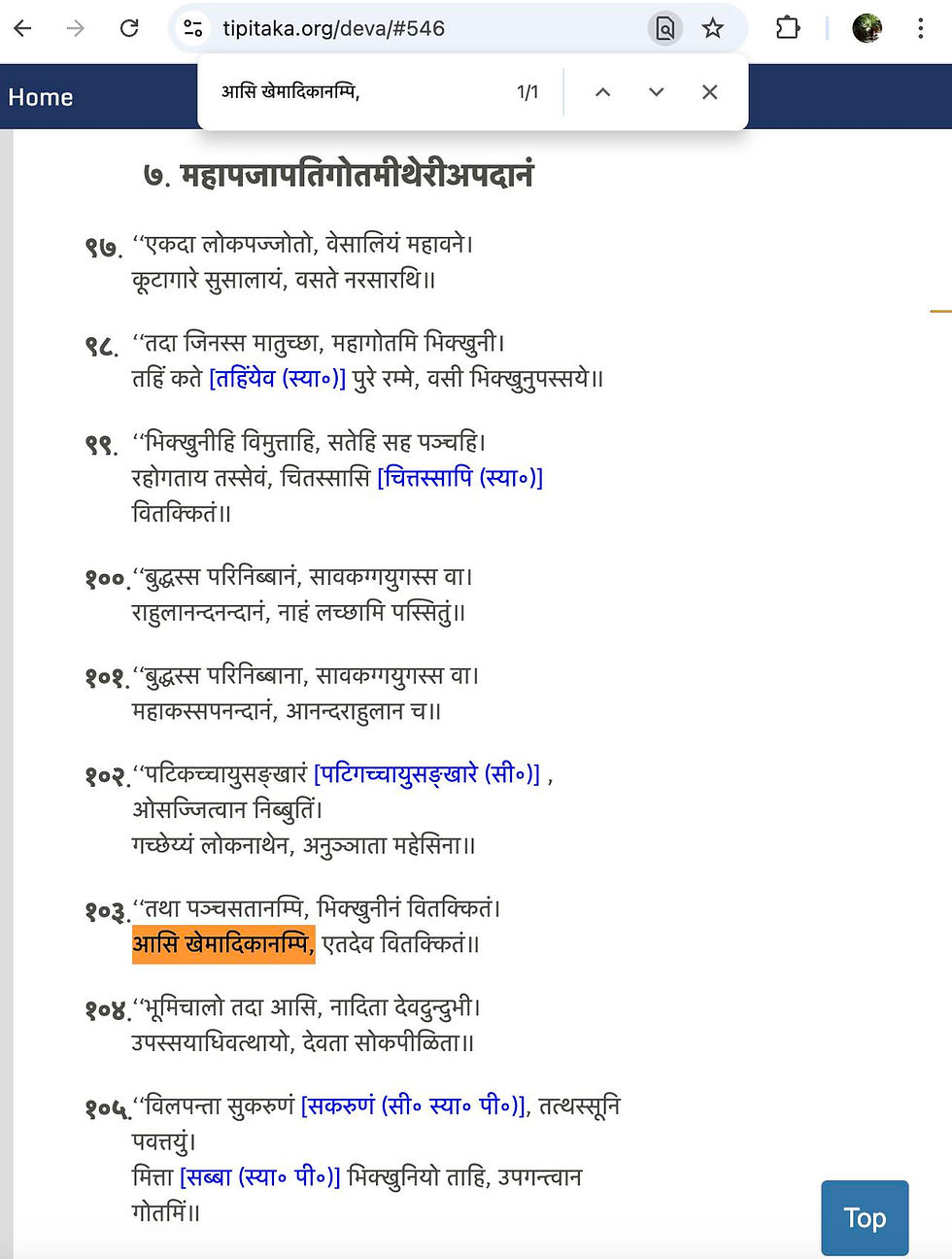
For those on Facebook, you're welcome to see the original post there and join in the discussion.










